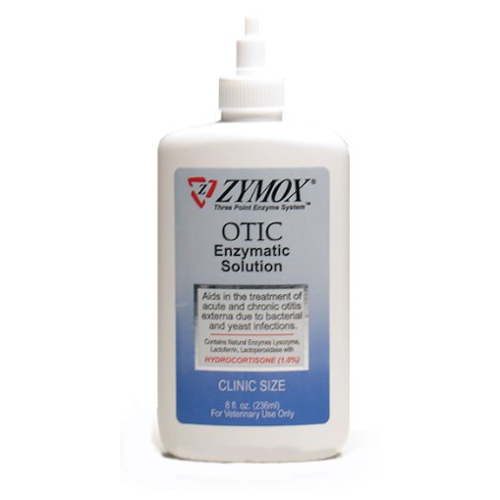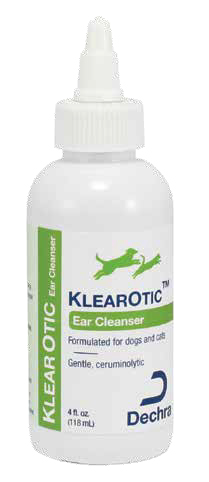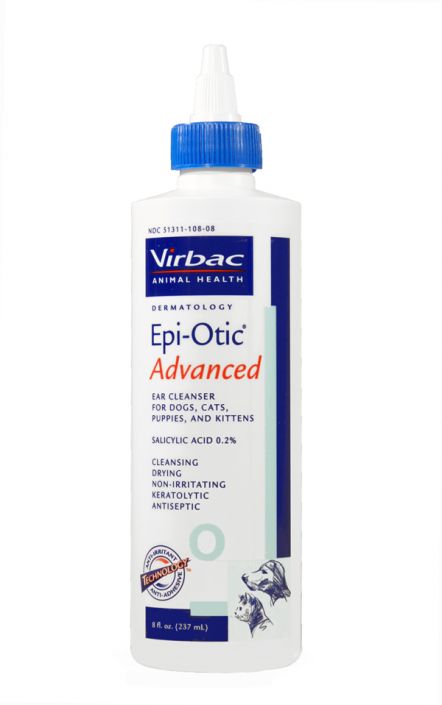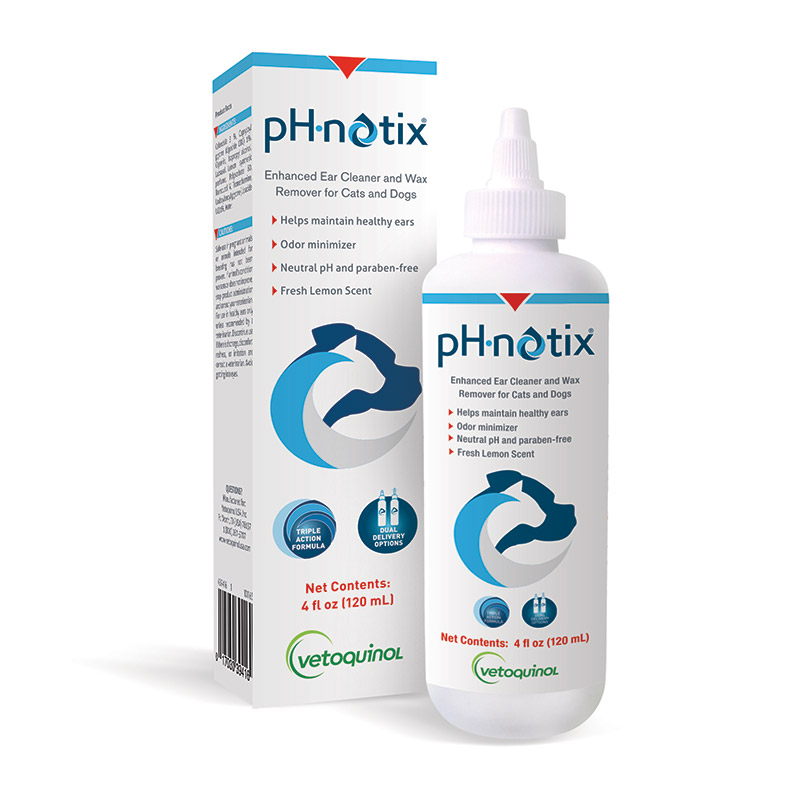Ear disease is one of the most common conditions in pets. The medical name for inflammation of the outer ear canal is ‘otitis externa.’ It is estimated that up to 20% of the dog population is affected by this disease and one study found that from 2% to 6.6% of cats admitted to hospitals were presented because of otitis externa.
Dogs and cats can have ear problems for many different reasons. When we see a pet with ear disease we need to think about the possibility of:
- Allergies: Pets with allergies, either to food or something they either inhale or that contacts their skin, often have ear problems. As a matter of fact, the ear problem may be the first sign of the allergy. Since the allergy changes the environment within the ear, we sometimes see secondary infections with bacteria or yeast. If we just treat the ear infection, we are not getting to the root of the problem. We need to treat the allergies too.
- Parasites: The ear mite, Otodectes cynotis, is a common cause of ear problems in cats, but less common in dogs. Some dogs are hypersensitive to the mites, however, and the resultant itching can be intense. Your pet may scratch so much they severely traumatize the ear.
- Ear Infections: Numerous types of bacteria and the yeast, Malassezia pachydermatis, cause ear infections. The normal, healthy ear has a good defense against these organisms, but if the ear environment changes due to allergies, hormone abnormalities, or moisture, the bacteria and yeast can greatly multiply and break down these defenses.
- Foreign Bodies: Plant awns, those little “stick-tights” that cling to our clothes and our pets’ fur, can sometimes enter the ear canal. Their presence causes irritation, the pet scratches, and before you know it we have a traumatized, infected ear.
- Trauma: As we described above, self-inflicted trauma to the ear due to scratching can exacerbate ear problems.
- Ear Environment: Bacteria and yeast could not ask for a better environment to live in than a warm, dark, moist ear canal. Dogs with heavy, floppy ears such as Cocker Spaniels may have ear problems due to the excess moisture that builds up in their ears.
Diagnosis
Because there are many potential causes of ear problems, we cannot just say it is a bacterial ear infection, dispense antibiotics, and it will go away. Often, more work is needed.
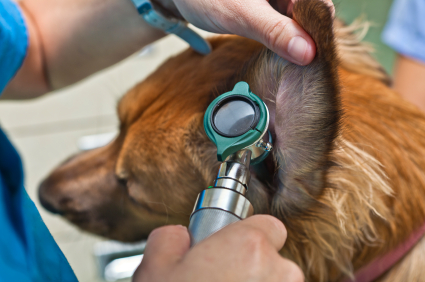
Your veterinarian can use an otoscope to look down into the ear canal and determine the amount of inflammation present, if the tympanic membrane (ear drum) is involved, and if there are any foreign bodies, tumors, or other potential causes of the problem. Swabs of the ear can be taken, smeared on a microscope slide, stained, and examined for bacteria, yeast, and mites.
A thorough history and physical exam may help determine if this could be a hormonal, allergic, or hereditary problem. If these are suspected, further diagnostic testing would be needed. If a bacterial infection does not respond to the first antibiotic therapy, a culture and sensitivity may need to be performed to select a different antibiotic.
Cleaning Ears
Your dog or cat’s ear is more L-shaped than yours, and debris loves to collect at the corner of the L. To remove this debris, apply an ear cleaner into your dog’s ear canal. Ear cleaners should be slightly acidic but should NOT sting. Massage the base of the ear for 20-30 seconds to soften and release the debris. Wipe out the loose debris and excess fluid with a cotton ball. Repeat this procedure until you see no more debris. Let your pet shake his head to remove any excess fluid. When you are through, wipe the pet’s ear flap and area below the ear gently with a towel. Depending on your pet’s ear condition, you may have to start out cleaning the ears twice a day. Always follow your veterinarian’s recommendations.
Cotton applicator swabs can be used to clean the inside of the earflap and the part of the ear canal you can see. They should NOT be used farther down in the ear canal since that tends to pack debris in the ear canal, rather than help to remove it.
After the ear is clean, allow some time for the ears to dry. Then you can apply any ear medication that was prescribed.
Signs of Ear Problems Include:
- Odor
- Scratching or rubbing of ears and head
- Discharge in the ears
- Redness or swelling of the ear flap or canal
- Shaking of the or tilting it to one side
- Pain around the ears
- Changes in behavior such as depression or irritability
Treatment
The treatment is going to depend on what caused the ear problem and what secondary conditions are there as a result. Antibiotics are used for bacterial infections and antifungals for yeast infections. Glucocorticoids such as dexamethasone are often used to reduce the amount of inflammation in the ear.
Ear problems caused by a systemic disease such as a hormone abnormality or allergy must include a therapy that treats the whole dog, such as hormonal replacement or allergy testing and hyposensitization (immunotherapy).
- Allergies: Allergies are commonly treated with regular ear cleaning with an ear cleaning solution, antihistamines, and fatty acid supplements. Sometimes corticosteroids are needed. These may be given in an oral or injectable form, or they can be applied topically. Allergy testing and immunotherapy (hyposensitzation) may be the best way to cure the ear problem.
- Ear mites: Ear mites can cause a dry, dark, crumbly debris in the ear that resembles coffee grounds. For this condition, ear cleaning followed by an ear medication to kill mites will eliminate the problem, although the treatment may need to be continued over several weeks depending upon the product used.
- Yeast: Yeast can cause severe ear problems. We usually observe a brown waxy exudate and a bad odor. Daily cleaning of the ears will help, but often these infections are difficult to treat, and special medications need to be given since antibiotics do not kill yeast. If you suspect a yeast infection in your dog’s ears, consult your veterinarian.
- Bacterial Ear Infections: Bacterial ear infections can also have a bad odor and often have a more yellowish exudate. If it is a severe or chronic condition, ear cleaning alone will not take care of the problem and antibiotics will almost always be necessary. Again, consult your veterinarian. Ear infections of the canal, if severe, can spread to the middle and inner ear, so prompt attention to the problem is always best.
- Regardless of the cause of the ear disease, we must always keep the ear canal clean.
Preventing Ear Disease
The key to healthy ears is to keep them clean. Check your pet’s ears weekly. A slight amount of waxy buildup may be present in normal ears. Excess hair around the ear can be clipped to allow more air flow. Follow your veterinarian’s recommendation on how to treat any underlying condition that predisposes your pet to ear problems.
Remember, if your dog is showing severe discomfort, the ears have a bad smell, or the ear canals look very abnormal, do not delay in contacting your veterinarian. If your dog has a ruptured or weakened eardrum, some ear cleansers and medications could do more harm than good.
Shop for Ear Treatment Products
Zymox HC 1.0% Enzymatic Solution
ZYMOX Otic is used in dogs and cats for the treatment of acute and chronic inflammation of the external ear caused by bacterial, viral and yeast infections.
KlearOtic Ear Cleanser
- For use in dogs and cats
- Gentle and non-irritating
- May be used prior to medication
- Excellent ceruminolytic
Epi-Otic Ear Cleanser
A non-irritating ear cleanser formulated with anti-adhesive glycotechnology to prevent microbial attachment.
pHnotix Ear Cleaner
pH•notix is a re-balancing ear cleaner for Cats & Dogs. It is a oil free, triple action formula that acts fast to clean ears and remove wax and debris.

